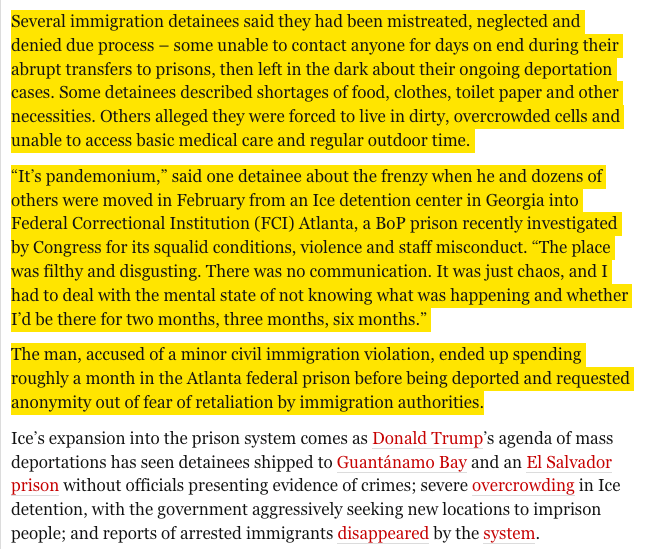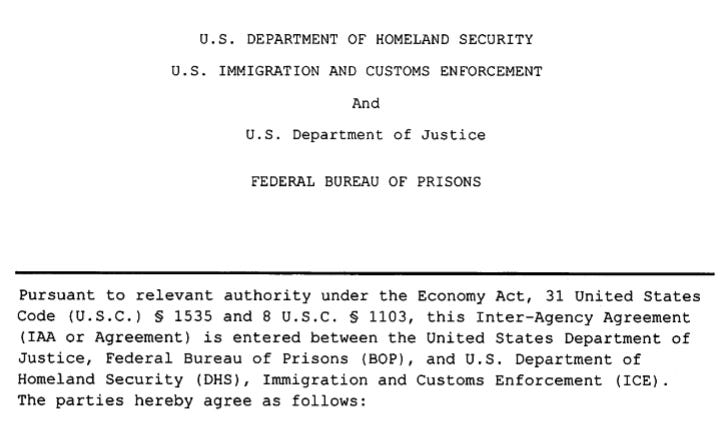Uncivil
Examining all the ways the ICE-BOP MOU violates the most important rule of the immigration system, and what advocates and litigators can do about it.
Sam Levin has a great piece out for The Guardian about the plight of immigrants ICE incarcerates under the purportedly “civil” immigration detention statutes. In Miami, Atlanta, Philly, Leavenworth, Kansas, and Berlin New Hampshire, the federal government is putting civilly confined immigrants in prison and calling it detention.
The sole justifications for depriving these “civilly” detained immigrants of their liberty are to ensure their appearance at removal proceedings and to facilitate their deportation if those proceedings don’t go their way. Immigration detention isn’t supposed to be punishment, so the spaces we detain people shouldn’t be the same spaces we use to punish them.
Here is a link to the agreement the Associated Press obtained between ICE and the Bureau of Prisons that facilitates these transfers.
Despite the paper guarantees in this MOU that the Bureau of Prisons will conform their treatment of detained immigrants to Trump’s watered down 2019 National Detention Standards — which ICE adopted in order to expand its human caging system to encompass jails that couldn’t meet the 2011 Performance-Based National Detention Standards — the physical and material reality experienced by every person transferred under this agreement is that they’re in a prison. That’s the reality Sam documents in his Guardian piece. It’s inescapable. This reality carries liberatory power.
The Law Of Civil Cages
You don’t have to read more than a few accounts of immigrants caught up in the system to see words to the effect of “they’re treating us like criminals.” But in many ways, from legal standpoint, civil immigration proceedings are worse. The Civil-Criminal distinction, invented by a 19th century Supreme Court hellbent on preserving the racist Chinese Exclusion Act through the genocidal law of Plenary Power, deems deportation to be anything other than punishment. By this juridicial sleight of hand, immigration enforcement bureaucrats arrest, imprison, and force labor from alleged noncitizens before immigration legal bureacrats dole out death sentences and banishment for purportedly “civil” violations. And that’s only if you’re lucky enough to avoid expedited removal or reinstatement.
People in imprisoned while in “civil” immigration proceedings don’t have a right to plead their case before a jury of their peers. Or to a speedy trial. Or to the federal rules of criminal procedure. Or to presentment before a neutral magistrate within 48 hours to test the probable cause supporting their arrest. Or, mostly, to a court-appointed lawyer. They don’t have the right to confront witnesses who offer testimony against them, and they generally don’t have a right to exclude illegally obtained evidence, except in cases of egregious or widespread constitutional violations. They don’t have a right to bail. The government doesn’t bear the burden of proof, aside from demonstrating alienage. And the government doesn’t have to show they’re a flight risk or a danger to society to keep them locked up. They don’t have right to proportionality, so that the punishment fits the crime. There’s no statute of limitations that forecloses the government from waiting decades after they’ve committed a civil infraction before hauling them to jail for it. There’s no Ex Post Facto prohibition. They don’t have a right to court-appointed post-conviction counsel. And they don’t even get to go before a real federal judge. (Immigration judges are DOJ employees who mostly used to be ICE trial lawyers. They have a dashboard that tells them how many cases they must complete, and can be fired if the exercise any meaningful independence). “Civilly” detained immigrants don’t have any codified rules of evidence to rely upon in the proceeding against them. There’s no Brady rule, and there are no pretrial disclosures the government must make. The prosecutors who bring cases against them can’t be sanctioned or disciplined by the adjudicators who decide their cases. So if an ICE lawyer falsely claims you’ve been convicted of a crime, and you prove they knew it was untrue when they made the claim, the judge has no power to sanction them. The ICE cops who make civil immigration arrests never have to come testify about those arrests. Unlike pre-trial detained people, immigrants get only so much process as Congress deems they’re due, and it’s not a lot. Immigration hearings have no court reporter, and the immigration judge functionally gets to preside and decide the case in secret if they feel like it.
This is the reality of being a “civilly” detained immigrant. Deportation isn’t punishment, the Supreme Court decided in the 1800s, so the Constitutional rights of the accused don’t apply.
But putting people in prison and exposing them to all of the meticulously documented harm that action entails is punishment. As a result, courts in the very places where ICE and BOP have decided to subject alleged noncitizens to imprisonment without trial or conviction have held for decades that such treatment, applied to other civilly confined humans, violates the Constitution.
Start with BOP’s Atlanta FCI, where Samantha Hamilton told the Guardian a client was disappeared such that he couldn’t attend the immigration court hearing for which he was purportedly detained by ICE. In 1984 (of all years), the U.S. Court of Appeals for the Eleventh Circuit held in Lynch v. Baxley, 744 F.2d 1452, 1458, 1462, that in light of the harsh conditions in Alabama’s jails, the Constitution’s Due Process Clause requires people in civil confinement for mental health adjudications to be “detained in the nearest state, regional, community, county or private hospital or mental health facility which provides quarters for mentally ill patients.” In Bilal v. GEO Care, LLC, F.3d 903 (11th Cir. 2020), the court confirmed that the burden is on the State to demonstrate the place where it is imprisoning civilly detained people is the least restrictive means of doing so. That would seem to cover Florida, where former ICE prosecutor and now-immigration removal defense attorney John Gihon’s client has been imprisoned in Miami.
The same law that prevents those civilly confined for mental competency proceedings from being incarcerated in the same facilities as criminally charged people extends to civilly confined state-designated “sexually violent predators”. See King v. County of Los Angeles, 885 F.3d 548 (9th Cir. 2018). This case exposes a long line of precedent tracing back to the Supreme Court’s decision 1982 decision in Youngberg v. Romeo, 457 U.S. 307, 322, where the court held, without dissent, that civilly involuntarily committed people are constitutionally entitled to more considerate treatment and considerations of confinement than criminally convicted people whose conditions are designed to punish.
What’s all this mean in practice?
One might imagine multiple lines of effort here.
For starters, an organization that provides pro bono legal services to civilly detained immigrants could team up with a putative class of their clients who face the risk of transfer to the prisons listed in the BOP-ICE MOU and sue to enjoin ICE and BOP from enforcing the agreement. They could ask a federal judge to find that it violates the binding Supreme Court and circuit jurisprudence discussed above by subjecting civilly detained accused non-citizens to conditions of confinement designed to punish. Ideally, the court would invalidate the agreement. But even if it does not, at the very least, the court could certify a class and appoint a monitor to regularly assess conditions inside the prisons for the very types of predictable atrocities Levin’s Guardian article documents. Smart anti-carceral immigration lawyers will realize there’s no DRIL hotline in prison. No DHS-OIG line. No LOP program. No least-restrictive-means attorney visit. No grievance box where you can talk to your ICE officer. No way to seek assistance from your family in getting your immigration paperwork. No meaningful access to the immigration court. And generally, more punitive conditions (by design) in prison than in the detention center. This alone should justify the injunction.
But all of the above is, admittedly, a pretty huge lift, resource-wise. Individuals in ICE custody who are transferred to BOP facilities could move to terminate their immigration proceedings and file habeas petitions seeking release, based on their unconstitutionally punitive detention. They could seek appointment of paid counsel, and the right to a bail hearing, since they’re now in functionally (if not formally) criminal sites of incarceration.
There’s also the reality that these transfers violate the Anti-Deficiency Act by failing to acknowledge the constitutional limitation placed on ICE detention appropriations — namely, that the custody be civil and not criminal. That violation can serve as the basis for an APA suit seeking a declaration that the MOU is final agency action contrary to law.
Even if you’re the type who finds all these moonshots fantastical and unworkable, the most natural thing to do for folks moving in solidarity with incarcerated non-citizens who become imprisoned at BOP facilities because of the government’s rapacious appetite to grow its human caging system would be to file a case challenging conditions of confinement.
Finally, we must acknowledge that for years, ICE detention centers have been far worse than prisons, according to nearly everyone who’s spent time in both places. But during those years, most people haven’t cared one bit about the plight of the folks swept up in each of those locations. Both parties have consistently invited the public to pretend they’re disappeared, that their lives don’t matter, and that whatever neglect, maltreatment, rape, torture, or death they experience, they probably deserved it. “Felons, not families,” some dude once said.
Those days are over. The horrors of the system are front and center. For judges, for press, for the public. So now is the time to put that system to the test and expose its fundamentally uncivil nature. It’s now or never.





